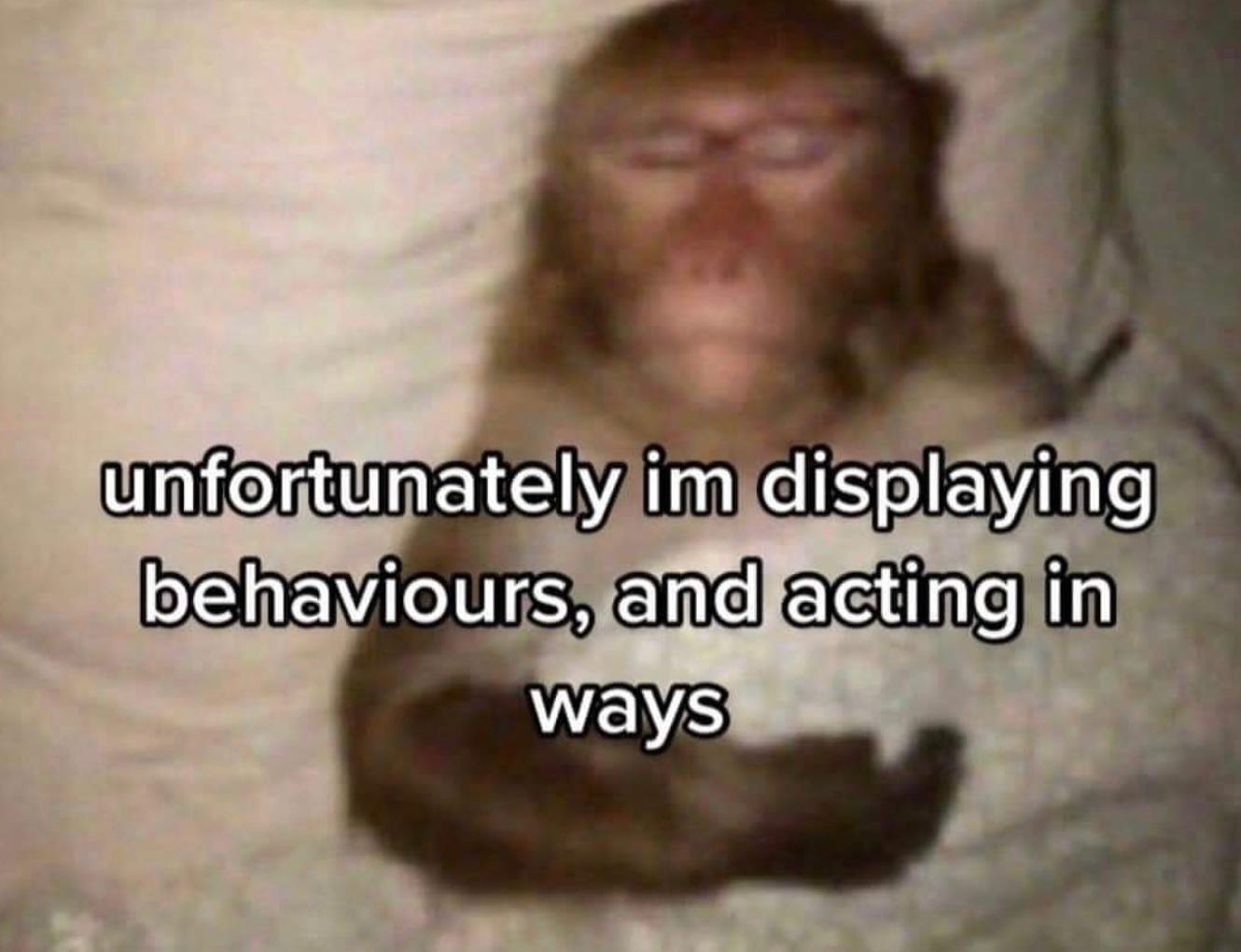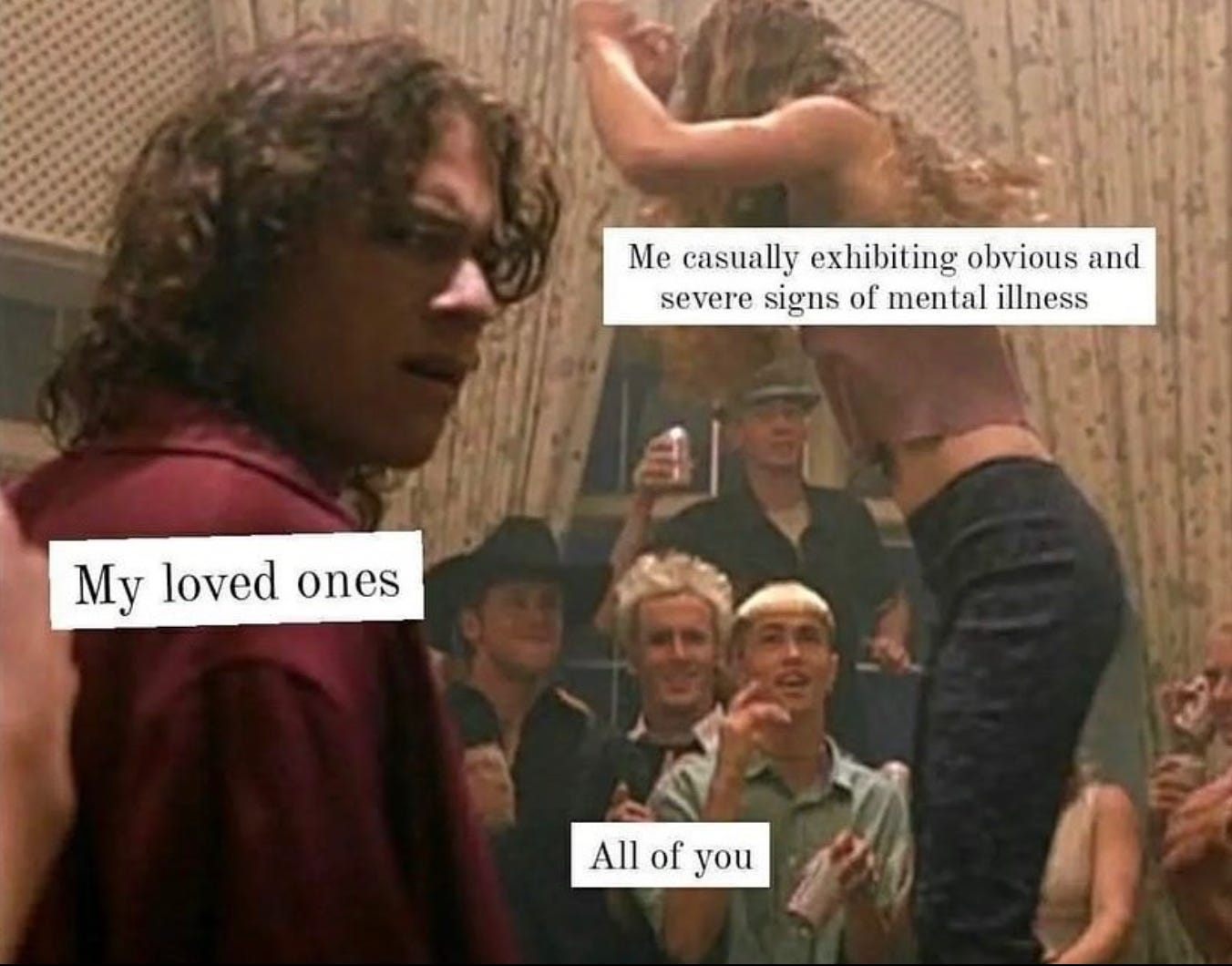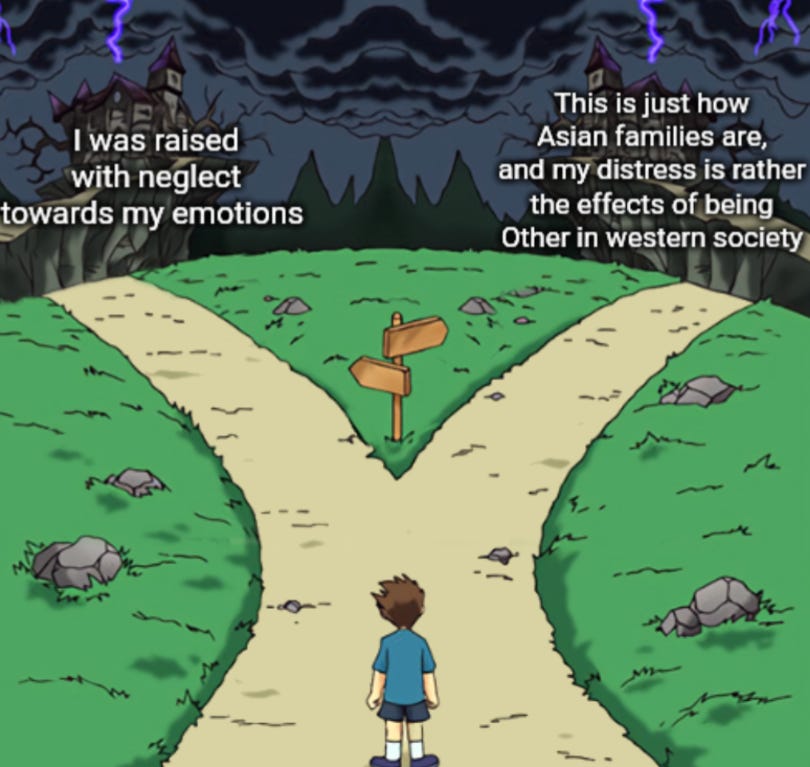I Graduated from Horse Tranquilizer Therapy!
Live, Laugh, Love, Ketamine 💓 or, What I learned while raw-dogging therapeutic K straight into my veins
Author’s Note-
I’ll write more about this later, and probably with more details, information and research— but this week, I finally finished my six-infusion ketamine therapy protocol! Like most information out there, it isn’t a silver bullet, but it did help me get out of this post-surgical funk that I couldn’t seem to shake even after my body felt fine.
A fair warning that this is an unpolished and fairly raw account of what the last month and a half or so were like. I talk about trauma and abuse, all of which relate to my complex PTSD and recurrent major depressive disorder. The irony of admitting and shouting my invisible illnesses out loud will get me comments about how brave I am, but I have to confess that I am lucky and privileged to have this platform. I’m also incredibly grateful I had access to a discounted version of this protocol, but the expense for ketamine infusions is quite pricy — paid out of pocket for it. I’ll discuss the information and details in a future essay, but for now — more so lessons I’ve learned. Oh, also any identities, details and information are obscured or changed in order to maintain privacy. I recall my situations the best that I can, but make it vague on purpose because these people don’t need your attention. If you don’t feel comfortable with this, skip ⏭️ this post!
Lesson One: Do Your Research, Know What You’re Getting Into

I am a doctor’s best and worst patient: I arrive armed with questions, advocate for myself with a shitload of research and clinical trial studies, and insist on working collaboratively in order to find working solutions. I willingly turned myself over to a rather expensive and, frankly, kind of scary new world under the supervision of experienced medical professionals because I was desperate for change. For literally anything because I did not know how to access all these pent-up emotions and I just wanted to HEAAAAAAAAAAL. I’ve been on the same dose of SSRI for years and while it’s been great for my anxiety, it wasn’t enough to help, especially with the fluctuations in hormones because of my endometriosis/adenomyosis pelvic pain. Given my many health conditions and complex medical issues, I chose infusions as the only viable treatment option. This process took about a month and a half before I actually moved forward with it— I contacted multiple clinics and providers before settling on Nushama as my provider. They are in NYC, out of network (unless you’re there for Spravato, the intranasal enantiomer/racemic version of ketamine, generically called esketamine) and are quite expensive. That being said, I knew it was worth the investment.
Six infusions given over three to six weeks, with escalating doses, seemed uncomplicated. I would meet with the medical assistants and nurses as they triaged and worked me up from vitals to IV insertion, then talk with a medical provider, before working with an integrator (normally a licensed therapist, but they have experienced psychedelic facilitators who aren’t) to set intentions for the journey and discuss whatever came up. After confirmation of the dosage, the nurse and integrator would tuck me into the chair, cocooning me in blankets. They would dim the lights, place an eye mask over me, and don the Beats by Dre headphones to whisk me away to another planet.
When the supervising psychiatrist and provider of the clinic I utilised described the infusion process as psychedelic and dissociative, I already knew what he meant. The first time I experienced ego death was during my second hour-long sensory deprivation float. The water temperature is just above the body — leaving a sensation of melting into the surroundings. With the lights and sound off, the tank turns into a willing prison of one’s own design. At first it was scary: How the fuck was I experiencing this sober? It felt like a cheat code for meditating! After the initial jolt of anxiety, I settled into the water, feeling it cradle my flesh with its buoyancy. I succumbed to the darkness and surrendered to the merging. If dissociating on ketamine was anything like that experience, I was confident I could handle it.
Lesson Two: Expect the unexpected, surrender to the process. Let go.

Even after extensive online research and discussions with experts, I remained uncertain about what would happen. I was lucky enough that my clinic sends pre and post-therapy integration worksheets that emphasized intention setting and provided resources to boost neuroplasticity and rewiring. Despite all that, I wasn’t quite sure what my intention for the first session was going to be other than allowing the medicine to do its work.
I’m going to be honest: My first session was uncomfortable. The initial session is always the longest because they have to dose you based on weight. After running through a series of tests and assessments — you’re not supposed to eat up to four hours before and drink up to two hours. I insisted they move the drinking time to one hour because there would be no good veins to stick if I wasn’t fully hydrated.
Despite having previous experiences of ego death — mostly sober — I dissociated hard and felt like I was in my personal game of Citizen Sleeper… only I wasn’t in outer space. I was digging myself deeper into the pits of the Underworld and dying 1000 deaths before disintegrating into specks of cosmic dust. I barely remember this first session now, even though it was around a month ago. Ironically, one of my biggest fears as a death working is, in fact, dying. The weird thing about k-holes is that my experience revolved around tapping into central consciousness1 but also experiencing the sensation of dying, no longer existing and coming to terms with that. As someone who went into the experience hoping for clarity, I came out of it frightened and alarmed. The visions themselves were mechanical and nature, like a never ending cyberpunk-inspired labyrinth with harsh geometric lines that somehow showed me the intricacies of my brain functions. My disappointment aside, I left that first treatment with renewed vigor and the start of threads I needed to unravel.
And then, you know, I unravelled rapidly.
Lesson Three: Lean into your support system. Treasure them.

One thing I hadn’t encountered in my research (but in hindsight makes perfect sense) was that things could appear to be worse before they got better. After my first session, I found this new-fangled sense of clarity. For the first time in my life, I was willing and able to talk about my history of childhood abuse and neglect and the unhealthy patterns that I learned. Turns out, stifling emotions and keeping secrets is very stressful. I had about 30+ years of baggage I kept locked in an armored fortress, and only a few people had access. For the first time in my life, the defenses were down. It was as if the first treatment unlocked the barriers and allowed the pent-up feelings to build up and explode.
For the next four days, I cried and sobbed uncontrollably.2 I found I had energy to do more, stick to self-care routines and name my stories. However even with the renewed sense of purpose, I succumbed to all the emotions flooding up, drowning me. The first session made me realize that going to these infusions was an adventurous day. No matter what time the session was, I had to devote the entire day to the process. Even though I was technically sitting in a chair, dissociating high out of my mind, there was still a lot of energy spent. And after that? The emotional integration piece of it all requires more mental and physical fortitude, pushing back against my self-defeating thoughts.
I could not stop crying.
My poor spouse had already booked a work trip for the following week and expressed concern that I would be alone with the dogs. He grew nervous, asking if I would be okay and if I had extra support as I had scheduled two sessions for the next week. My therapist, who I hadn’t seen in a couple weeks because of other circumstances (holidays, vacations, etc.) upon finding out I embarked on this process, echoed these fears. She pulled out the “As one of your providers…” card and asked me if I could reschedule one appointment for when my partner returned. I hadn’t taken other providers seriously before when they expressed doubt and concern about my life, but their firm stance shocked me to my core. It was a rupture in our therapeutic relationship and I took it seriously.
After our session, I quickly texted all my close friends to see if any of them could accompany me home from the session, and then make sure I wasn’t alone too long afterwards. When the next week rolled around, one of my close friends ushered me home and stayed with me until my other friend tapped in. I could not be grateful enough that my tiny community locked in on a request and mutual aid came through. I deeply appreciate the love and gratitude I feel for my chosen people.
I knew I felt the love when I realized that I ended every session, no matter how scary, with laughter, a huge grin and a perma-smile on my face.
Lesson Four: Your past really does affect your present. But it doesn’t have to determine your future.

The strangest part of having c-PTSD is admitting that I suffered from trauma. My old therapist used to tell me that no one leaves childhood unscathed, and that comment was enough to swear me off having offspring. Growing up with undiagnosed ADHD and hypersensitive and high-achieving immediate family members helped me realise that much of the conflict happened because they did not have enough information, time or capacity to raise me the ways I needed. And that’s okay. I grew up fairly well-resourced, and I’ve forgiven people along the way.
The weird thing about ketamine and the neuroplasticity aspect of it all, is that I’ve gained a lot more agency and energy to change. One of the medical providers at the clinic often uses the metaphor of ketamine acting as a springboard, to which I immediately retorted: Are you fucking kidding me? It’s a tsunami. I felt everything, I could see that what happened to me was not normal. And I mourned, grieved and cried through the entire process. But what trauma took away from me, ketamine helped me gain back with a boost in the work I was already doing. I admitted to my loved ones of wanting to hermit forever. After everything I had been through in the last few years, I no longer wanted to jump into things just to hurt myself and others— I, instead, wanted to practice moving with ease and slowness. I wanted to grow become a better person, and that helped change my perspective. I found that I wanted to take better care of myself, started building a self-care ritual and meditated once a day.
The medicine was potent, but a huge push in a new direction. I still have a lot of work and more growth ahead, but just allowing myself to admit these things and tell my story is powerful enough. Plus, my PHQ-9 and GAD-7 scores decreased over the span of six sessions so it helped.
Lesson Five: Call it what it is— abuse.
When someone asks me about the worst relationships I’ve had, I can only think of three. When I look back, I was only truly in love with one of them and even that person, I’m unsure if what I experienced was truly real because of what’s come to my attention over our time apart. To be honest, I feel icky even writing this because part of me is still in denial over the sunken-cost fallacy, and the other part cannot be sure if I can fall in love with someone I never truly knew and could never truly know me. It’s weird because I also feel a sense of responsibility, even though many abusive relationships tend to share a component of reactive abuse. Hurt people hurt people, after all. I’m not saying that it was healthy and I know I hurt others, and even those I’ve come to understand as my abusers were also hurt by my actions. But the impact is greater than the intent. And so therefore, ketamine gave me the greatest gift of them all: I can call it plainly for what it was— abuse.
I don’t think the people who inflicted harm necessarily did it purposefully, at least that’s what I’d like to believe. But I do think that, to some of their admissions, they’ve suffered a lot of trauma or hurt over their lifespans and therefore, explode and blow up. The gamut range from selfish to careless. Never once did I think any of them were truly evil, though I think my friends would beg to differ. In fact, because of the big emotions I felt, I often ignored when my loved ones would comment about the ways these people treated me.
At the end of one of my relationships, my ex and I started screaming at each other at midnight on street corners on our walk home. I kept my therapist on speed dial, texting her whenever I could and asking her for extra time to chat. I begged my partner to go to couples’ therapy—something they originally suggested, but we kept putting off because of the never ending crises that kept piling up—only to realise that we were too late. Love could not be enough to save us, and mainly because the ex kept fighting to win instead of trying to work towards saving the relationship. I knew our time was ending and wanted to end it with grace and ease by using couples therapy to figure out a way to de-escalate things. And just before one of our last sessions, in a fit of panic, they confessed to information that irreparably damaged our romance for good. It was an extremely traumatic experience for me, and my body went into full flight mode. I dissociated and felt my hands move on autopilot. I shook with rage and anger. That may have been the sharpest rupture I’ve experienced, but the red flags had been there all along.
My partner was forever evasive about certain topics, often preferring to avoid talking about it altogether. At first I thought my ex was just maintaining strong boundaries, something I admired because I grew up as a people-pleaser. Soon, I learned that it was a common pattern, as was their penchant towards inconsistency and avoidance. They would shower me with love one day, and the next, get upset with me for not being super attentive— despite the fact that I had explained that my neurodivergence causes me to space out. In fact, my ADHD caused huge rifts in this relationship. But so did their substance use.
The clash between the two culminated in a huge fight where my partner angrily berated me in a drunken stupor about how terrible of a partner I was. The fact that I didn’t read their mind and accommodate their needs (which they did not communicate,) and didn’t break my necessary routine to make room for them was so bad. Never mind the fact that I had animals to care for amidst chronic illnesses and ADHD, a neurodivergent disorder that tends to do better with a structure. They yelled at me for symptoms I cannot change, especially after sharing my insecurities with them not even weeks earlier about how my ADHD has caused issues in the past. I went to bed sobbing silently, crying myself to sleep. I had never been more scared in my own home than that evening. I walked my pets outside for some fresh air and quietly tucked myself back in the sheets. What seemed like hours later, my ex stumbled into the bedroom, reeking of whatever alcohol they could scrounge from my kitchen, and attempted to stir me up with cuddles. I shook in fear, my body stiffening up at the scent and pretended to be asleep so that I didn’t have to deal with any of this. The next day, I went about my morning routine and I was about to leave when my ex finally clocked my silence. Did I do anything wrong?, they asked. Pausing in my tracks, checking my phone for the time— I knew I had to say something at the expense of missing one of my crucial health appointments. But okay, here we go. I recapped the entire night, my voice trembling in fear: You don’t remember yelling at me for something I cannot change about myself? If my ADHD bothers you, I don’t think we could be a good fit. I told you this a week ago and then you screamed at me for it and told me that I made this week horrible for you.
One of many events in the span of our time together, but the first time I put my foot down and told my partner that if they ever did something like this again, I would leave. Of course, I didn’t. I would continue to get yelled at for reasons they made up in their head. A concern of mine, pointing out patterns that felt inconsistent and therefore, caused insecurity, was made out to be a vicious attack. I practiced non-violent communication, transformative justice and accountability work— and I was met with gaslighting and stonewalling in response. In fact, when I finally left, my ex asked what I would tell people about our breakup. Why are you using betrayed and traumatized? That feels harsh for what happened, they commented in between asks for continued support and shared resourcing.
I went no-contact and blocked them on everything. I left a neutral third party in charge of communications if we needed to ever get in contact, but I needed space. Abusers find a way to keep tabs though. Even though I delineated and set clear boundaries, my exes still found information about me (this is why I hate being a semi-public figure,) stalking my socials without my consent, lying about why I left them and minimizing my feelings and the impact they left behind in the process. I thought these people shared the same abolitionist, liberation-based values that I did, and yet? They continued to police and perform punitive actions.
So I documented everything relentlessly. I saved screenshots, our chat history, voice messages. I learned over the years with my abusers, that abusers cannot be reasoned with. The gaslighting was real, and I had to even input some of the messages into AI in order for it to spit out specific phrases where a partner used the DARVO technique on me, or where they could not take accountability or responsibility. One of my exes even used “technicalities” and technically not breaking protocol (what the fuck does that even mean?) as an excuse to avoid apologising. These are all signs of abuse. I hate that these people are part of my lore. I HATE that other people are going to be irreparably harmed by them, the ways the people they’ve loved before were hurt and the ways they’ll hurt others in the future. So I learned to call these people by who they are to me: My abusers.
I have immense love and compassion for them all, despite all the harm done. But I can’t lie and deny my truth anymore. I call it what it is: Abuse.
And I refuse to let my abusers get the satisfaction of fucking up my life. I’ll keep fucking rebuilding and hopefully, I’m in a new chapter where I can discern who is willing to work and communicate with me.
And lastly? This was fun, but I don’t necessarily want to do it again.
The six infusion process was trippy. As Dickens once wrote: It was the best of times, it was the worst of times. But honestly, it all kind of melted together into one giant wormhole of confusion. I don’t regret doing it. I’m glad I tried. But if I can avoid it, I probably won’t do it again.
Ketamine was a push in the right direction—toward clarity, toward seeing things I had spent years twisting into softer shapes. It gave me back pieces of myself that trauma tried to steal. But it was also expensive, disorienting, and at times, terrifying.
When my friend picked me up after one of my infusions, she joked that I was finally fulfilling my destiny as a Horse Girl™, getting shot up with horse tranquilizer. And yeah—ketamine is traditionally used as an anesthetic, but society only freaks out about it because of the dissociation and psychedelic effects. Which, if you think about it, is probably why it’s used for horses.
They can’t tell us when they’re tripping balls.
I don’t think I need to go back. At least, not now. Somewhere between the k-holes, the unraveling, and the laughter at the end of every session, something shifted. Not in a way that erased the past, not in a way that fixed everything. But enough. Enough to make me want to keep going, keep building, keep choosing people who meet me where I am.
I still have work to do. I still have healing ahead. But for now, I can sit with the fact that I named it all—what happened, what it did to me, what I want to leave behind. That’s enough for today.
And Look, I know this seems dubious, but it’s the best way I can describe it. It’s sort of I like tapping into the Matrix and realizing we’re all interconnected.
I wish this was an exaggeration, but I really did cry non-stop day and night. That first session and the tidal wave of emotions did a number on me.






Thank you for sharing this. I’m contemplating low-dose lozenge ketamine sessions with my therapist for all of the reasons you recount in your own journey. It is invaluable to read first hand experiences. Especially since I’ll have a better idea of what after care will be like! Wishing you the most easeful healing possible <3